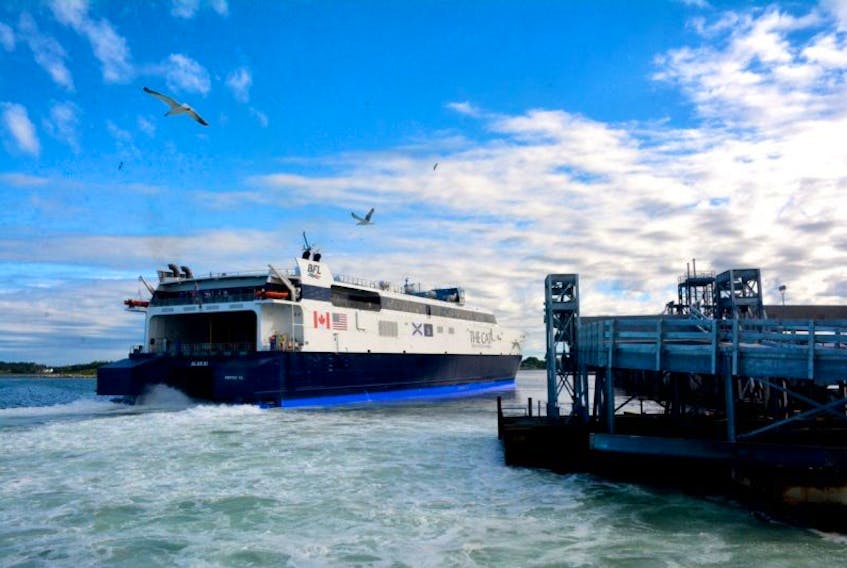YARMOUTH, N.S. – Bay Ferries is accepting bookings for the 2018 season of the Cat ferry, but for this season to be happening it requires costly upgrades in customs equipment at the ferry terminal in Portland.
The security upgrades are a necessity for service spelled out by U.S. Customs and Border Protection (CBP). Footing the $1.5 million bill are Bay Ferries and the Nova Scotia government.
Last year CBP said unless upgrades were made there would be no customs services. Without that there could be no ferry service.
“Initially, they had been seeking more than $7 million in upgrades for this season,” says Marla MacInnis, a spokesperson for the Department of Transportation and Infrastructure Renewal, who says the agreed-upon work clears the way for the Nova Scotia-Maine ferry service in 2018.
The funding will cover licence plate readers and radiation portal monitors required by U.S. Customs and Border Protection. The equipment is portable and designated for this ferry service.
Bay Ferries says its budget carries contingencies for work to be done at terminals.

2018 SEASON
The Cat’s season begins on June 8 and runs to Oct. 8. There are 108 daily round trips between Portland, Maine and Yarmouth, Nova Scotia. Last year The Cat ran into engine problems that forced a modification of its season and only allowed for 84 round trips instead of the planned 112. Still, the ferry – operating in its second season – saw an increase in passengers, carrying 41,623 in 2017 compared to 35,551 in 2016.
Bay Ferries president and CEO Mark MacDonald says the engine issue was disappointing.
“It was very disappointing because we knew what kind of a trajectory we were on in terms of our end-of-season sales,” he says. “On the other hand, I’ve never been more proud of the people that I work with because we had to re-engineer the whole business very quickly and build the new schedule . . . and had a pretty good year in the process so that makes us optimistic moving forward.”
MacDonald said last week the engine repairs were 75 to 80 per cent complete. The engine manufacturer is covering all of the costs.
MacDonald says Bay Ferries worked with U.S. Customs and Border Protection all winter to ensure ferry service for this year. He says part of the customs equipment that has to be installed was removed from the terminal when ferry service stopped after 2009. MacDonald says the equipment will provide more efficient processing of passengers and shorter processing time, which is good for everyone.
“These are the kind of issues that we deal with regularly in this business. There is a financial cost, which forms part of the cost of the ferry service,” he says.
The City of Portland has stated it wouldn’t pay for the required CBP upgrades. But the city says it wants to see ferry service continue.
"The City, Bay Ferries and USCBP are continuing to finalize arrangements for the 2018 ferry season," says Jessica Grondin, director of communications for the City of Portland. "In the meantime, it's business as usual and all of us are looking forward to a strong season and a continuation of last year's progress." The city's Economic Development Committee was meeting March 20 to where on its agenda is a vote to recommend to the City Council the acceptance of an amended lease agreement with Bay Ferries for space at the Ocean Gateway Terminal.
Asked if this year’s customs equipment work is a stopgap until next year, MacDonald says, “Our objective, ultimately, is to get the service to a place where it’s predictable, sustainable and out of the news and in the market and where customers can rely on it from year to year without there being annual discussion.”
He does say there is ongoing consideration to perhaps making use of the port of Bar Harbor in the future. There has also been talk of a pre-clearance customs centre in Nova Scotia but that’s a complex issue.
MARKETING
Bay Ferries says it will be carrying out its usual robust marketing centred on, but not exclusive to, the U.S. northeast. Aside from its own marketing Bay Ferries works in conjunction with Tourism Nova Scotia, which markets the province to visitors.

Bay Ferries will continue to do all of the provisioning for the ferry in Nova Scotia, using Yarmouth and Nova Scotia supplies and products for the Sip@Sea onboard food operation and the gift shop, which provides employment to locals and Nova Scotians.
Over the past two seasons, local residents have also been employed and trained as visitor information counsellors on the boat to assist ferry passengers with travel information about Nova Scotia.
“Fueling is done on the Nova Scotia side and all of our maintenance is done on this side and our crew resides on this side during the summer. It’s actually the first time in the history of the Yarmouth ferry service that the ferry has been based in Yarmouth with the exception of a very brief period back in 2006,” MacDonald says, noting previous ferries have often gotten their provisions on the U.S. side. “Now everything happens in Yarmouth so we’re quite proud of that.”
With the late evening arrivals and early morning departures of the ferry Yarmouth is where people start or end their trips – which benefits this area, particularly for the accommodations sector – but visitation from the ferry is spread throughout the province. In an opinion piece she wrote last year, Tourism Industry Association of Nova Scotia (TIANS) president Darlene Grant Fiander said there is an economic impact from the ferry service and to look at it solely as a cost because of a subsidy is wrong and doesn’t take into totality the benefit of the service to the province’s tourism picture due to passenger visitation and expenditures in Nova Scotia.
Beyond this, she said, “over 70 new jobs have been created directly as a result of the service; 50 companies from Nova Scotia are supplying goods and services; the ferry company is spending over $11 million of its operating costs here with $4.4 in fuel being purchased in Canada. A number of new businesses have started and existing businesses have expanded.”
Last year the province committed $9.4 million for the operation of the ferry. What the province will spend on the service this year was to be outlined in the provincial budget presented on March 20 said the Department of Transportation and Infrastructure Renewal.









